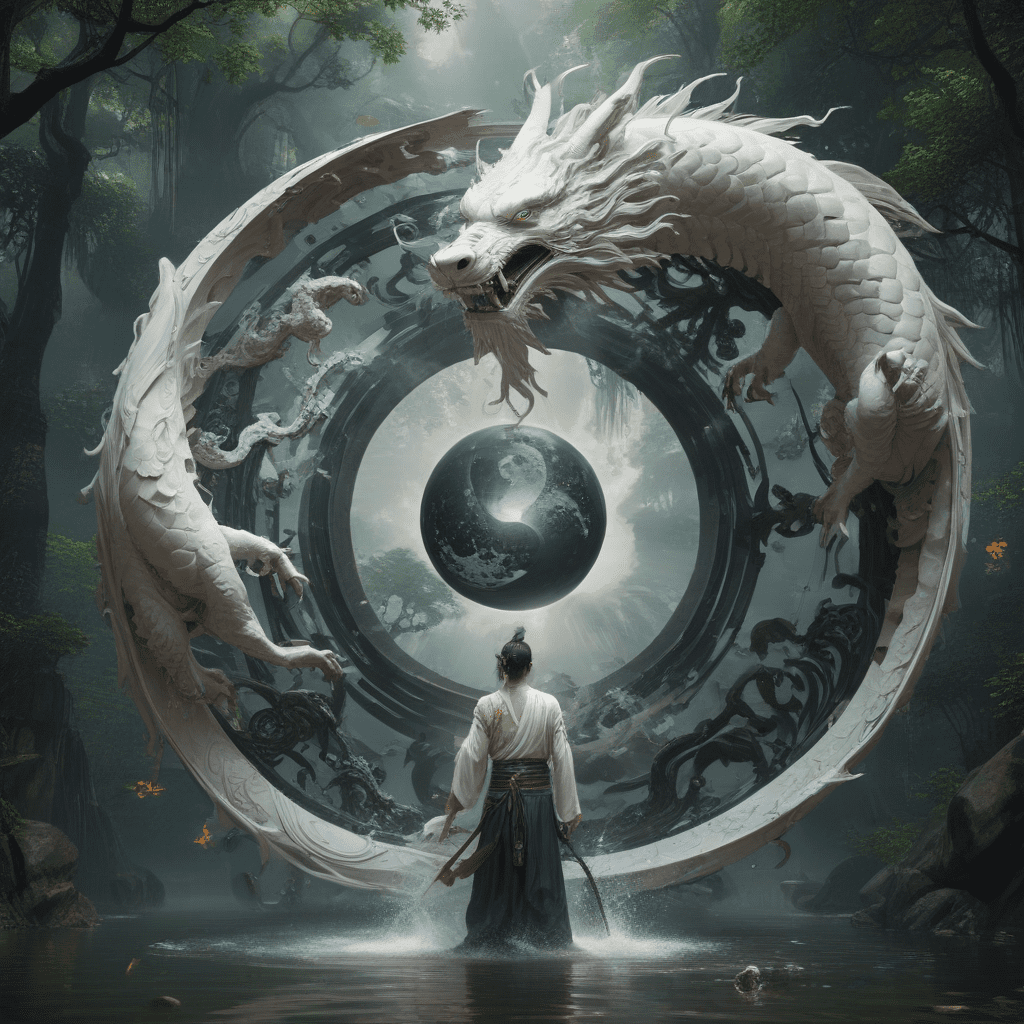Yin and Yang in Chinese Mythology
Introduction
Yin and Yang are fundamental concepts in Chinese mythology, symbolizing the opposing yet complementary forces that underlie all existence. Their interplay is believed to govern everything from natural phenomena to human affairs.
Origin and Meaning of Yin and Yang
The terms Yin and Yang are derived from the characters for "dark" and "light," respectively. They represent the two sides of a spectrum, with Yin representing passivity, darkness, coolness, and inwardness, while Yang embodies activity, light, warmth, and outwardness.
The Duality of Yin and Yang
Yin and Yang are not static concepts but represent a dynamic duality. They are constantly interacting and transforming into each other, creating a harmonious balance. This balance is essential for the proper functioning of both the natural world and human society.
6. The Taijitu: A Symbol of Yin and Yang
6.1. Description and Significance
The Taijitu is an iconic symbol that represents the dynamic balance of Yin and Yang. It consists of a circle divided into two equal halves, one black and the other white. Within each half, there is a small dot of the opposite color, symbolizing the concept of interdependence and transformation.
6.2. The Eternal Cycle
The Taijitu represents the continuous cycle of Yin and Yang. As one force reaches its peak, it gradually transforms into its opposite, creating an eternal flow that ensures balance and harmony. This concept is reflected in the changing seasons, the natural rhythms of the body, and the ebb and flow of life events.
7. Yin and Yang in Traditional Chinese Medicine
7.1. Diagnosis and Treatment
In Traditional Chinese Medicine (TCM), Yin and Yang are used to diagnose and treat imbalances in the body. Practitioners believe that illnesses result from an imbalance between these two forces, leading to symptoms such as fatigue, pain, and digestive issues. Treatment involves restoring balance through acupuncture, herbal remedies, and lifestyle adjustments.
7.2. Maintaining Harmony
TCM emphasizes the importance of maintaining Yin-Yang harmony for optimal health. This includes balancing activities (Yang) with rest (Yin), eating a balanced diet, and engaging in stress-reducing practices. By maintaining harmony, individuals can prevent illnesses and promote overall well-being.
8. Yin and Yang in Feng Shui
8.1. Energy Flow and Balance
In Feng Shui, the ancient Chinese art of placement and design, Yin and Yang principles guide the arrangement of elements within a space to create harmony and balance. Yang energy is associated with active areas such as kitchens and living rooms, while Yin energy represents quieter spaces like bedrooms and bathrooms. By balancing Yin and Yang elements, practitioners aim to promote well-being, productivity, and positive energy flow.
8.2. Creating Harmonious Environments
Creating harmonious environments through Feng Shui involves identifying the flow of Qi (energy) in a space and aligning it with Yin and Yang principles. This can be achieved by arranging furniture, using appropriate colors, and incorporating natural elements to create a balanced and supportive environment.
9. Yin and Yang in Chinese Philosophy
9.1. Daoism and Confucianism
Yin and Yang play a fundamental role in Chinese philosophy, particularly in Daoism and Confucianism. In Daoism, the concept of Wuji (the void) gives birth to Yin and Yang, which then manifest as all existence. Confucianism emphasizes the importance of balancing Yin and Yang in personal and social life to achieve harmony and virtue.
9.2. The Ultimate Harmony
The ultimate goal in Chinese philosophy is to achieve a state of equilibrium or balance between Yin and Yang. This harmony is considered essential for personal fulfillment, social order, and the wellbeing of the world. By embracing both the active and passive aspects of existence, individuals can strive for a harmonious and meaningful life.
10. Conclusion
Yin and Yang are fundamental concepts in Chinese mythology, representing the complementary and ever-changing forces that govern the universe. They provide a framework for understanding nature, human affairs, and the path to harmony and balance. By embracing the teachings of Yin and Yang, individuals can strive for a life in which these opposing forces are in equilibrium, leading to greater well-being, prosperity, and inner peace.
FAQ
What does Yin and Yang represent in Chinese culture?
Yin and Yang represent the opposing yet complementary forces that underlie all existence, such as darkness and light, passivity and activity, and inwardness and outwardness.
How is Yin and Yang used in Feng Shui?
Yin and Yang principles guide the arrangement of elements within a space to create harmony and balance. Yang energy is associated with active areas, while Yin energy represents quieter spaces.
What is the ultimate goal in Chinese philosophy regarding Yin and Yang?
The ultimate goal is to achieve a state of equilibrium or balance between Yin and Yang, which is considered essential for personal fulfillment, social order, and the well-being of the world.





